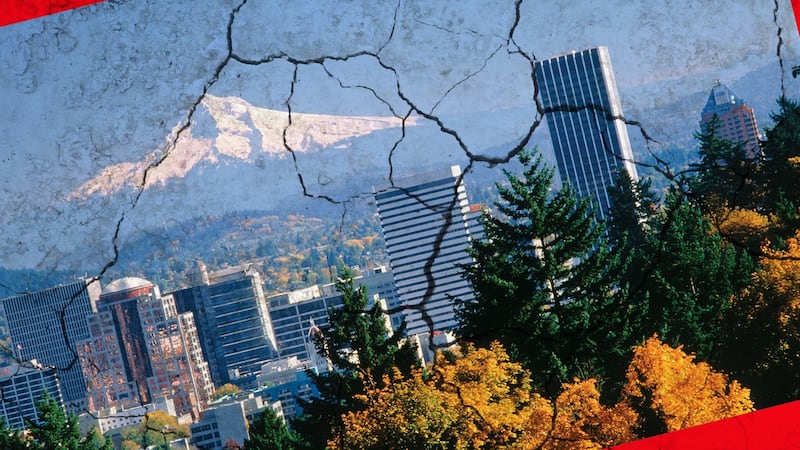
What will the apocalypse look like? Ever since Nov. 8, it's been hard not to imagine the United States morphing into a lawless, post-nuclear wasteland ruled by Immortan Trump. Yet Oregon faces a threat that's arguably more dangerous than the rise of any despot, the looming Cascadia earthquake.
It's a terrifying prospect, especially in the wake of New Yorker writer Kathryn Schulz's notorious 2015 article, in which Kenneth Murphy of the Federal Emergency Management Agency ominously declared, "Everything west of Interstate 5 will be toast." The quake is predicted to devastate Portland and up to 140 square miles of the Pacific Northwest—quite an event for a city where a few inches of snow is considered a "Snowpocalypse."
When I first heard about this, I shelved it in one of the back corners of my mind, near my youthful love of The Phantom Menace. When I finally read "The Really Big One," I was stabbed with despair: the collapse of a million buildings and our region's economy. According to FEMA, thousands of people will die.
There's not much we can do about that. What's the best way to give ourselves a fighting chance? Build a disaster preparedness kit.
It's not hard to find a list of items for that kit. But before you start shopping, pause for a minute and think about your overall strategy.
"There's a lot of groundwork that needs to be done before you even start worrying about the kit," says Althea Rizzo, geologic hazards program coordinator at Oregon Emergency Management.
Rizzo says the key isn't to hit Costco and stuff everything on the Red Cross' exhaustive list into a big duffle bag, it's to make plans to stash that stuff wherever you expect to be when the quake hits.
"We really recommend that people look at their lifestyle, look at where they spend time, and just squirrel away food and supplies there," she says. "Make sure you have a flashlight at work or a gallon or two of water. Maybe that's all you can put in your cubicle, but if you do, it'll still be more than you had yesterday."
You'll want to spread supplies across multiple locations—and in your car, which will be in multiple locations.
"We recommend people keep seven to 10 days' worth of supplies in their car because we're Americans, so we usually have our cars with us," Rizzo says. "So if you have seven to 10 days of supplies at your office and seven to 10 days of supplies in your car, that's two weeks' worth of supplies."

Of course, if disaster strikes while you're at work, you're still going to need a way to get home. The Hawthorne, Steel, Interstate and Fremont bridges are expected to collapse. Anyone who needs to cross the Willamette should prepare to walk across the revamped Sellwood Bridge or Tilikum Crossing, both of which are earthquake-resistant.
Rizzo is also quick to emphasize that communication is crucial to surviving any natural disaster. That's why picking a post-fallout meeting spot for family and friends is important, as is tapping a relative who lives outside the impact area as an emergency contact.
The other pressing issue is water. If you've got water, you've got at least a few days to figure things out.
"One gallon per person per day is the rule of thumb," says Monique Dugaw, director of communications for the Red Cross in the Cascades region. When expanding your kit, Dugaw says water, nonperishable food and first-aid supplies "are the three basics to start with."
Rizzo also emphasizes the importance of post-disaster hydration. "At home, I have 14 days' worth of water for two people," she says "But that's probably not going to be enough. So what I have is a couple of different ways to purify water."
This is something anyone can do. A basic water-purification straw costs $14 on Amazon, allowing you to stash them in your car, house and office.
The more I talked and read and learned, the more I realized that survival, like anything, depends on strategy.
"Most of the people who died in the Indonesian earthquake and tsunami died because of the tsunami," Rizzo says, "and they died because they did not know what to do."

Welcome to the 2016 Health & Fitness Issue
How I Learned to Fight, And Why All Women Should Take a Self-Defense Class
We Tested Five Complete Nutrition Meals, The Foods of our Very Bleak Future
Here's How to Begin Preparing for the Looming Cascadia Earthquake
Five Products That Will Help You Survive the Cascadia Earthquake
I Spent 10 Days In Silent Meditation, And It Was Brutal
Is Your Yoga Practice Cultural Appropriation?
How Adaptogens, the Hormone-Regulating Family of Herbs, Are Shaping Discussions of Chronic Stress


